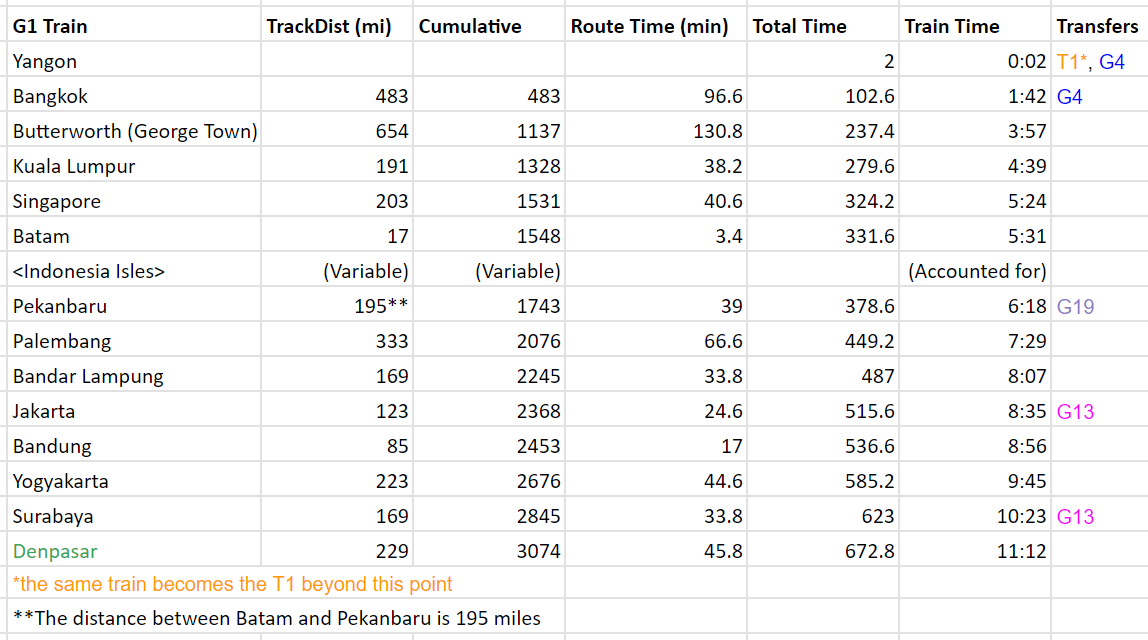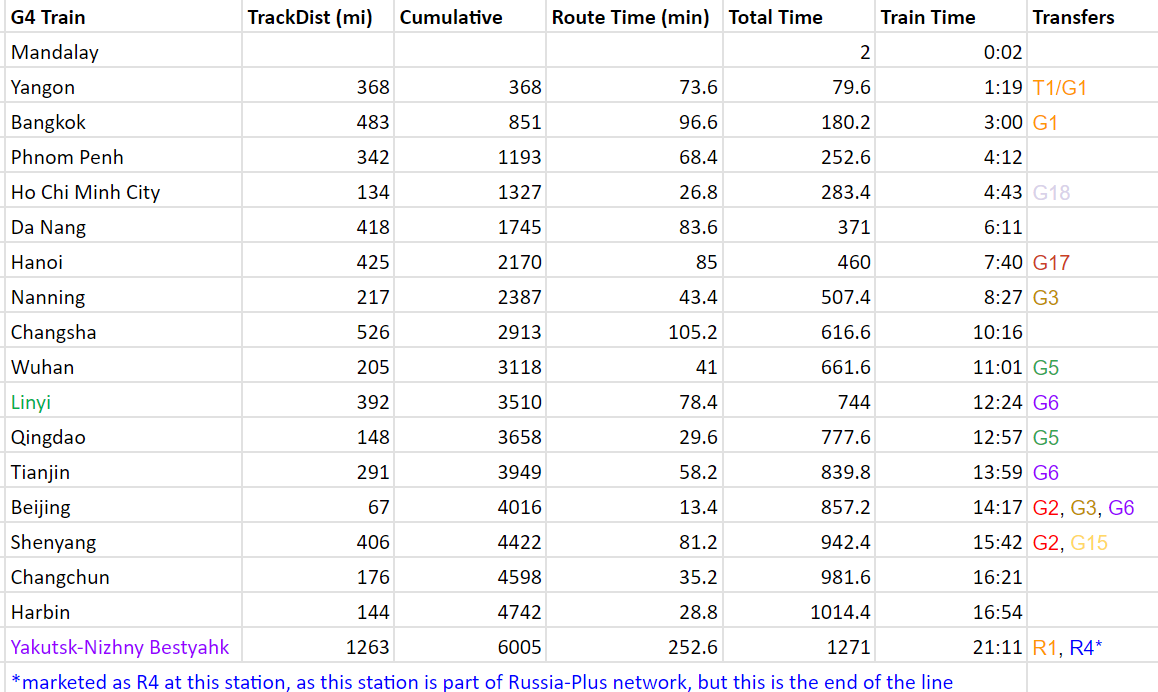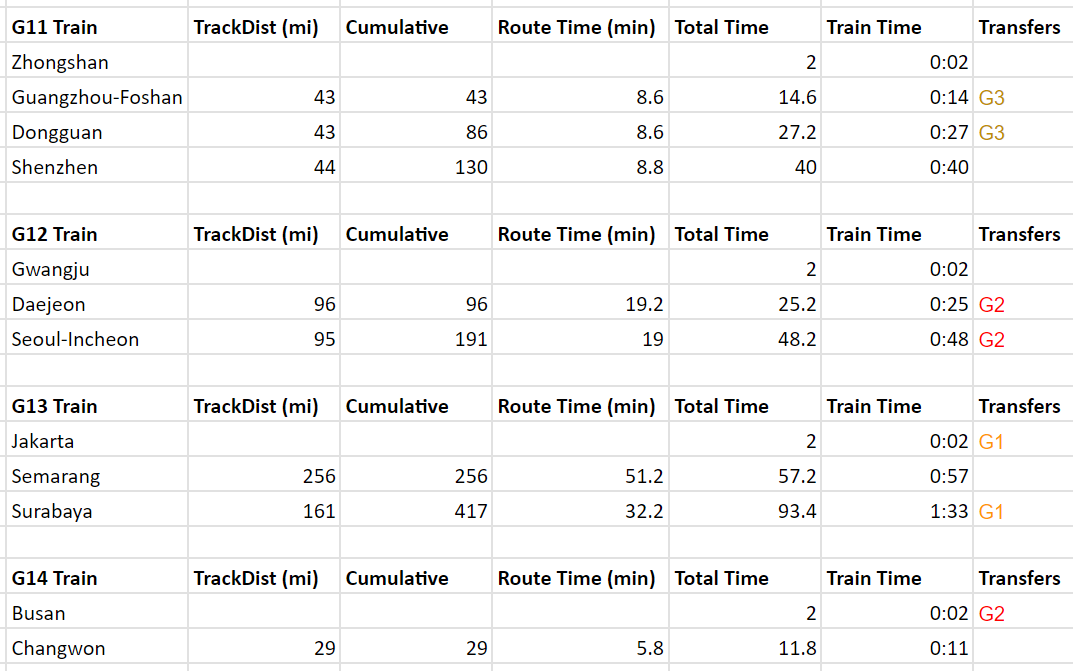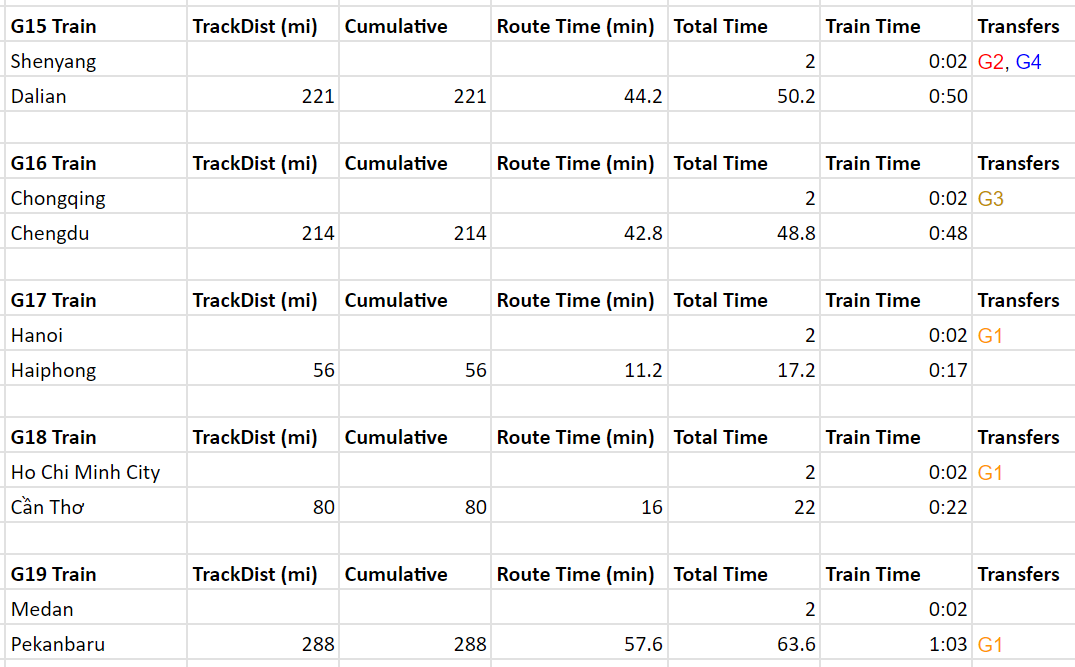Calling this network “Greater Asia” is probably a misnomer, but it’s the part of Asia that most people think about first when it comes to Asia. So I’ll give its trains the G code here.
There’s a few interesting features that we get to discuss right away.
First, most of the map is in a moderate risk zone. That’s China. Trust in the Chinese Communist Party is… limited. The country is massive, though, and I set the largest minimum for any country for a qualifying city: 3 million. Also, the density of some Chinese cities and the desire to limit the size of the map yields a fair few directional distortions.
This limited trust also causes me to deny a Hong Kong station outright. I see little good can come of allowing a direct connection to the Chinese network1.
Two countries present high risk: Burma and North Korea. There’s not much we can do to avoid them, though. We’ll discuss North Korea’s situation further when we discuss the G2 line both of its stations lie on.
Linyi is a helper station necessitated for routing purposes. Tsushima and Iki are small islands in Japan that we’ll run our line through. Denpasar is added to the end of the G1 line because of Bali’s popularity for tourism. Connecting the islands of Indonesia, where feasible, is important.
Speaking of that… I use Tennessine’s “closed station” notation at a place called “Indonesia Isles”. This isn’t really a closed station, or a single station at all. It’s actually… a lot of stations. I’m not technically even sure exactly how many. Between Batam and Pekanbaru, the best route runs through quite a few of Indonesia’s smaller islands. It’s generally considered bad behavior to run transit through an area and give its people no viable access to it. And yet, I can’t really give full service to every single island. That would slow up the line massively for incredibly low demand: most of these islands are very low population. So the solution is for every train to stop at *one* of the islands, passing through the other stations unimpeded. They’ll rotate through, so we have limited service to each island. The G1 timing reflects this single stop2.
It might have been technically possible to get to Davao in the Philippines, but it wouldn’t have been reasonable to get to any of the country’s other major cities, and we’d really have to push ourselves to the limits to get there and overall it just doesn’t feel worth it. On the flip side, we are able to include Indonesia, but Makassar is a qualifying city in Indonesia that we just don’t have the ability to reach with our defined limits of feasibility.
With all this in mind, let’s look at the lines.
G1 Line:
Our “world” line ends in Denpasar, Bali, Indonesia, after traveling from Santiago, Chile, in 6 days, 17 hours, 20 minutes — just under a week to see quite a bit of the world’s land and complete the world’s longest train! This will have the usual 60-minute service throughout its length. It does sort of miss most of this network, but I wanted to avoid lines looping back on themselves, especially at an incomplete time, so I felt it was best to not attempt to proceed towards China. I suppose I could have proceeded to do what the G2 does, but this just made more sense to me.
G2 Line:
The G2 train runs through China, both Koreas, and terminates in Japan. Yes, it’s possible to run a line from Korea to the heart of Japan, as long as we service the two small Japanese islands along the way.
If anything, the most dubious part of this is actually running through North Korea. Dandong-Sinuiju is just on the China-North Korea border, and has that international station status, where it should be theoretically possible to exit on either side3. I actually think that North Korea would be willing to — if paid enough — allow the line to run through. But it’s likely that actually exiting into Sinuiju or Pyongyang (or entering that station) would be made very difficult by the North Korean regime. Ultimately I care more about the line itself than I do about the regime’s one-and-a-half stations. Many people will probably think of this stretch as a direct from Dandong or even Shenyang to Seoul-Incheon.
Through Japan, this line functions as a ‘super-shinkansen’, quickly connecting all (or at least most of) the major cities with very limited stops. This is a big contrast to China, where we spend over 8 hours from Astana, Kazakhstan to Beijing with just a single stop in between.
This train runs every 60 minutes. A G22 train runs between Hiroshima and Sapporo every 60 minutes with a 30-minute offset. A G32 train runs similarly between Seoul-Incheon and Busan.
G3 Line:
Ulaanbaatar is the only non-Chinese station on this line, and it definitely takes ‘the long way’ to Shanghai, going more or less all around the country, being China’s primary travel line. In many cases, it will be more practical for travelers near Beijing or Shanghai to use other lines, but it’s more for people going between various other places in China.
This train runs with 60 minute frequency.
G4 Line:
The G4 is one of our main lines running through the region, proceeding through much of Southeast Asia, then going to China, before finally becoming the R4 for an almost instantaneous moment at Yakutsk where it terminates. This is a 60-minute train.
G5 Line:
The G5 connects a lot of important cities, and a lot of them are quite close together. Indeed, a case could be made that all of Suzhou, Wuxi, and Changzhou shouldn’t get stations as they’re simply all very close to each other. Ultimately I decided the tradeoff was worth it with simply how big these are. I think this is likely a 30-minute frequency train simply due to how many people are in this area (At least, 30-minutes during the day, probably back down to 60-minutes at night.)
G6 Line:
The G6 provides the direct connection between Beijing and Shanghai. This corridor is vital and I’m willing to also call this a 30-minute frequency train during the day as a result (with 60-minute frequency at night).
Greater Asia’s Minor Lines:
The G11 covers the heavily populated Guangzhou greater metro area and should probably run on 30-minute frequency during the day, with 60-minute frequency at night.
The G12 and G14 are the two South Korean trains, and will run on 30-minute frequency.
The G13 provides the alternative to the G1 between Jakarta and Surabaya. This should be a 60-minute service train.
The G15, G16, G17, G18, and G19 are all simple runs between two large cities in the same country where it simply didn’t make sense to get a major line to them. These should all be 60-minute frequency trains.
And that’s a wrap. Every major network completed, everywhere I can reasonably connect major cities (and quite possibly a few less reasonable options), we’ve done it!
Or… is it?
So, we’ve connected the major cities internationally, but what if… we wanted more? There are actually several interesting things we can do from here, and I may explore some further options. This bonus content will certainly be a while away — my next post should be discussing my trip to England and Spain. After that, I’ll be into the start of the Spring semester and will likely be too busy to engage much with new posts, but I’ll settle in eventually.
If you have any specific ideas for bonus content, please do either leave a comment or find me on Discord. I already have a couple of ideas, but hearing from people will help, for sure, and as long as there’s continued interest and good ideas, we’ll keep going.
See you around the Internet, and maybe someday, around the world!
On a similar note, with the limits of feasibility, it actually might have been possible to make the leap from Taiwan to the mainland, but this is also not going to happen until the two countries acknowledge each other’s rights to exist.
Essentially, 4 minutes to complete an additional stop get added.
Notably, this metro area meets the 1M worldwide population standard for getting a station. But it needs to be largely considered a North Korean station to work, because it does not meet the 3M China minimum. Overall I felt it was better to place this station here than not.












